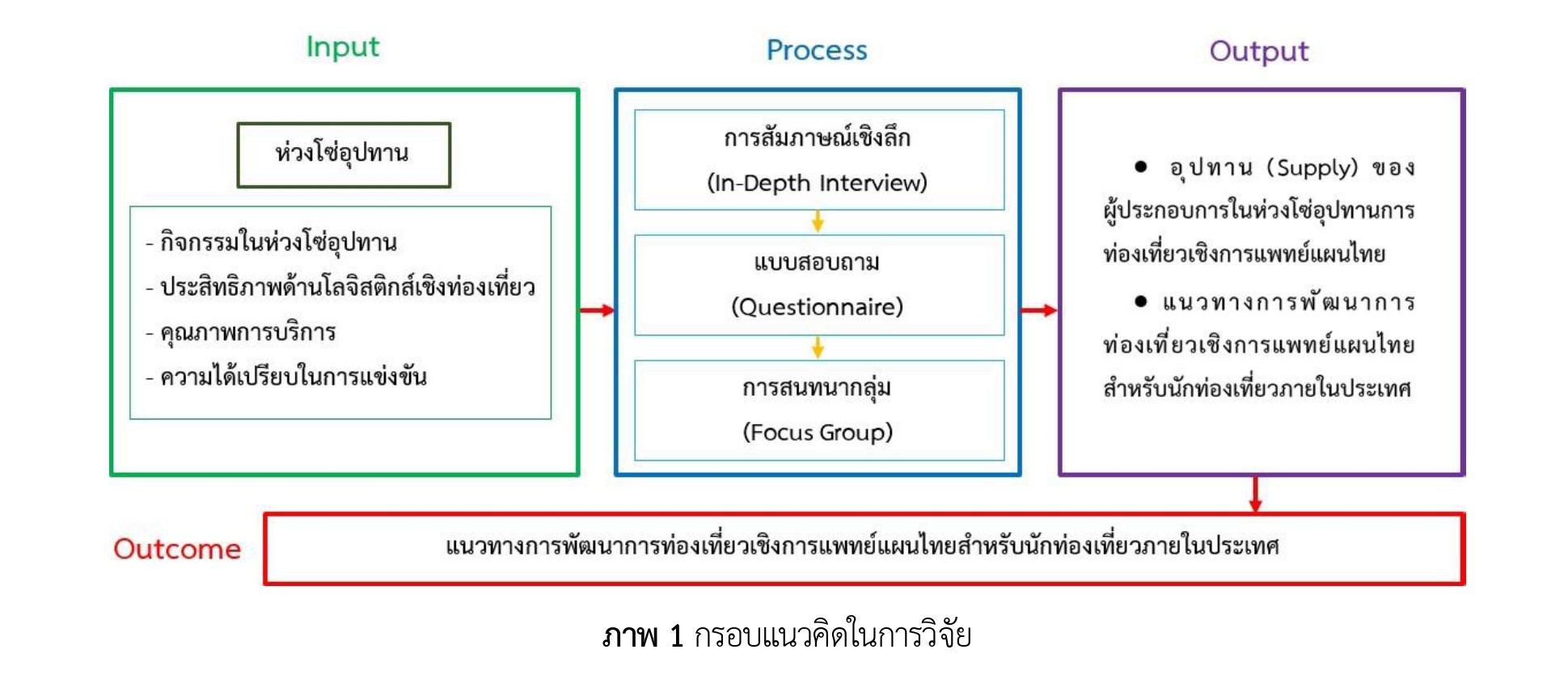Guidelines for The Development of Thai Traditional Medical Tourism for Domestic Tourists After The COVID-19 Pandemic
DOI:
https://doi.org/10.14456/psruhss.2024.8Keywords:
New normal, Thai traditional medicine tourism, Tourism development, Tourism supply chainAbstract
The objectives of this study were to: 1) Study the supply chain of entrepreneurs and 2) Propose guidelines for the development of Thai traditional medical tourism. The method of this research consists of two types of research methods which are a qualitative research by collecting primary data. As for the qualitative research, it studied of supply by implementing in-depth interviews method focusing on a specific sample group including logistics specialists such as Confederation Director Thai Federation On Logistics, Travel Service Standards Specialist, Phataravej Siam Clinic and Phataravej Siam Thai Traditional Medicine School, Purita Thai Massage School Administrator, PHiPhi Coral Company Tour Operator and Consultant Federation Thai Spa and The Westin Grande Sukhumvit Hotel. The data collection of quantitative research was a study by questionnaires. There were 488 local tourists as a sample group who were served by Thai traditional medical tourism. Afterwards, the data collection of qualitative and quantitative research were combined in order to conduct group discussions with relevant targeted groups. Specific specialists were identified, including logistics and supply chain, health tourism and Thai traditional medicine, and entrepreneurs. To set guidelines for the development of Thai traditional medical tourism. The result of the research has shown that 1) Thai traditional wellness tourism is characterized by its Thai identity and uniqueness especially, Thai herbs and authentic massages of each region. For example, the northern region represents Lanna medicine recipes. “Tum Hayahari Punchai” shows the symbol of Central Region. Whilst, identity of Isan Civilization is presented in Northeastern region. Ban Hao, Eastern Region is a sign of blending Thai traditional massage and western. Moreover, southern sciences raises the identity of Langkasuka massage. Tourists pay attention to the most relevant factors as follows: activities in the supply chain are herbal products, service quality is trust, efficiency in tourism logistics is customer service and the competitive advantage is efficiency. 2) Guidelines for the development of tourism can be a new way of life after Covid-19 pandemic which is presented 3 approaches: (1) Thai traditional medicine attracting social conservation tourism (2) Medical activity tourism “The Next Normal” Thai Plan for Economic Sustainability and (3) Sustainable Herbal Ecotourism.
References
กรมเจรจาการค้าระหว่างประเทศ. (2554). ธุรกิจบริการ : สปาและนวดไทย. นนทบุรี: กรมเจรจาการค้าระหว่างประเทศ กระทรวงพาณิชย์.
กรมสนับสนุนบริการสุขภาพ. (2562). รายงานผลการวิจัยและสำรวจข้อมูลด้านบริการสุขภาพและบริการเพื่อส่งเสริมสุขภาพของไทยประกอบการจัดทำศูนย์ข้อมูลรองรับนโยบาย Medical Hub. กรุงเทพฯ: พิมพ์ทันใจ.
กอบกาญจน์ วัฒนวรางกูร. (2558). ท่องเที่ยวชุมชนไทย มั่นคง มั่งคั่ง ยั่งยืน. สืบค้น 10 มกราคม 2565, จาก https://tattourismjournal.files.wordpress.com/2016/01/7_tourism_forum_2016.pdf
บุญเรียง ขจรศิลป์. (2543). วิธีวิจัยทางการศึกษา (พิมพ์ครั้งที่ 5). กรุงเทพฯ: พี.เอ็น.การพิมพ์.
พุทธชาด ลุนคำ, และรชฏ เลียงจันทร. (2564). Research Intelligence: ธุรกิจท่องเที่ยวและโรงแรมหลัง COVID-19. กรุงเทพฯ: ศูนย์วิจัยกรุงศรี. สืบค้น 10 มกราคม 2565, จาก https://www.krungsri.com/th/research/research-intelligence/ri-future-of-tourism-21
สำนักงานปลัดกระทรวงการท่องเที่ยวและกีฬา. (2563). รายงานภาวะเศรษฐกิจการท่องเที่ยว : COVID-19 กับผลกระทบต่อการท่องเที่ยวไทย ปีที่ 1 ฉบับที่ 4 กรกฎาคม - กันยายน 2563. กรุงเทพฯ: สำนักงานปลัดกระทรวงการท่องเที่ยวและกีฬา.
Aliman, N. K., Hashim, S. M., Wahid, S. D. M., & Harudin, S. (2016). Tourists’ Satisfaction with a Destination: An Investigation. International Journal of Marketing Studies, 8(3), 173-188.
Bag, S., Gupta, S., & Luo, Z. (2020). Examining the role of logistics 4.0 enabled dynamic capabilities on firm performance. The International Journal of Logistics Management, 31(3), 607-628.
Cochran, W. G. (1953). Sampling Techiques. New York: John Wiley & Sons.
Debata, B. R., Patnaik, B., Mahapatra, S. S., & Sree, K. (2019). Interrelations of service quality and service loyalty dimensions in medical tourism. Benchmarking: An International Journal, 22(1), 18-55.
Delic, M., Eyers, D. R., & Mikulic, J. (2019). Additive Manufacturing: Empirical Evidence for Supply Chain Integration and Performance from the Automotive Industry. Supply Chain Management: An International Journal, 24(5), 604–621.
Lee, Y. Y., & Falahat, M. (2019). The Impact of Digitalization and Resources on Gaining Competitive Advantage in International Markets: The Mediating Role of Marketing, Innovation and Learning Capabilities. Technology Innovation management review, 9(11), 26-38.
Liao S. H., Hu, D. C., & Ding, L. W. (2017). Assessing the influence of supply chain collaboration value innovation, supply chain capability and competitive advantage in Taiwan's networking communication industry. International Journal of Production Economics, 191, 143–153.
Mulyana, A., & Ayuni, D. (2019). Applying Service Quality Model as a Determinant of Success in E-learning: The Role of Institutional Support and Outcome Value. Review of Integrative Business and Economics Research, 8(1), 145-159.
United Nations World Tourism Organization. (2004). Concepts & definitions: Sustainable development of tourism conceptual definition. Retrieved January 10, 2022 Retrieved from https://www.unwto.org/ frameset/frame_sustainable.html

Downloads
Published
How to Cite
Issue
Section
License
Copyright (c) 2024 Humanities and Social Sciences Journal of Pibulsongkram Rajabhat University

This work is licensed under a Creative Commons Attribution-NonCommercial-NoDerivatives 4.0 International License.
Any articles or comments appearing in the Journal of Humanities and Social Sciences, Rajabhat Phibulsongkram University, are the intellectual property of the authors, and do not necessarily reflect the views of the editorial board. Published articles are copyrighted by the Journal of Humanities and Social Sciences, Rajabhat Phibulsongkram University.








